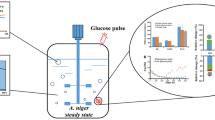Abstract
Depending on the biomass yield on glucose and the cell morphology ofBacillus thuringiensis, three different metabolic states were observed in continuous culture. At dilution rates between 0.18 h−1 and 0.31 h−1 vegetative cells, sporulating bacteria and spores coexisted, while glucose and amino acids were consumed. Only vegetative cells were observed at dilution rates between 0.42 h−1 and 0.47 h−1 and glucose was used as the main carbon and energy source. AtD = 0.50 h−1 the biomass yield on glucose decreases sharply. To define better the specific growth rate range in which the microorganism uses mainly glucose, a dilution rate of 0.25–0.45 h−1 was studied. The experimental data could be adjusted to a Monod model and the following rate coefficients and growth yields were determined: maximum specific growth rate 0.54 h−1, saturation constant 0.56 mg glucose ml−1, biomass growth yields 0.43 g cells (g glucose)−1, and 0.76 g cells (g oxygen)−1, and maintenance coefficients 0.065 g glucose (g cells)−1 h−1 and 0.039 g oxygen (g cells)−1 h−1.
Similar content being viewed by others
References
Anderson TB (1990) Effects of carbons:nitrogen ratio and oxygen on the growth kinetics ofBacillus thuringiensis and yield bioinsecticidal crystal protein. MSc Thesis, The University of Western Ontario, Canada
Arcas J, Yantorno O, Ertola R (1987) Effect of high concentration of nutrients onBacillus thuringiensis cultures. Biotechnol Lett 9:105–110
Atkinson B, Mavituna F (1991) Biochemical engineering and biotechnology handbook, 2nd edn. Ellis Horwood, New York, pp 136–155, 178
Avignose-Rossa C, Mignone C (1993) Delta-endotoxin activity and spore production in batch and fed-batch cultures ofBacillus thuringiensis. Biotechnol Lett 15:295–300
Brousseau R, Masson L (1988) Biochemistry of sporulation ofBacillus thuringiensis insecticidal crystal toxins: gene structure and mode of action. Biotechnol Adv 6:697–724
Byung Ch, Sang Y, Ho N (1992) Enhanced spore production ofBacillus thuringiensis by fed-batch culture. Biotechnol Lett 14:721–726
Dawes IW, Mandelstam J (1969) Biochemistry of sporulation ofBacillus subtilis 169. Continuous culture studies. In: Malek I, Beyan K, Fenel Z, Munk V, Ricica J, Smrková H. (eds) Continuous cultivation of microorganism, Academic Press, Prague, pp 157–162
Dawes IW, Thorley HM (1970) Sporulation inBacillus subtilis. Theoretical and experimental studies in continuous culture systems. J Gen Microbiol 62:49–66
Dawes IW, Kay D, Mandelstam J (1969) Sporulation inBacillus subtilis. Establishment of a time scale for the morphological events. J Gen Microbiol 56:171–179
Ertola R (1988) Production ofBacillus thuringiensis insecticides. In: Aiba S (ed) Horizons of biochemical engineering. Oxford University Press, New York, pp 187–202
Holmberg A, Sievanen R, Carlberg G (1980) Fermentation ofBacillus thuringiensis for exotoxin production: process analysis study. Biotechnol Bioeng 22:1707–1724
Käppeli O, Fiechter A (1981) On the methodology of oxygen transfer coefficient measurements. Biotechnol Lett 3:541–546
Mercado MM (1994) Efectos de la limitación de oxígeno a partir de la fase de transición en el metabolismo y producción de delta endotoxina deBacillus thuringiensis. MSc Thesis, CINVESTAV-IPN México
Miller GL (1959) Use of dinitrosalicylic acid reagent for determination of reducing sugar. Anal Chem 31:26–428
Pirt SJ (1975) Principles of microbe and cell cultivation. Wiley, New York, pp 63–70
Razo FE (1991) Estudios para el escalamiento de un proceso por lote de nivel de laboratorio a planta piloto para la producción deBacillus thuringiensis. MSc Thesis, UNAM México
Rodríguez MM (1991) Cultivo por lote alimentado para la producción de bioinsecticidas a base deBacillus thuringiensis. MSc Thesis, CINVESTAV-IPN México
Rodriguez MM, Torre MM de la, De Urquijo E (1991)Bacillus thuringiensis: características biológicas y perspectivas de producción. Rev Latinoamer Microbiol 33:279–292
Rowe GE (1990) Central metabolism ofBacillus thuringiensis during growth and sporulation. PhD, Thesis, University of Western Canada
Rowe G, Margaritis A (1987) Bioprocess developments in the production of bioinsecticides byBacillus thuringiensis. Crit Rev Biotechnol 6:87–127
Roy BP, Selinger LB, Khachatourians (1987) Plasmid stability ofBacillus thuringiensis (HD-1) during continuous phased cultivation. Biotechnol Lett 9:483–488
Sakharova ZV, Ignatenko NY, Khourychev MP, Likov VP, Rabotnova IL, Shevtson VV (1984) Sporulation and crystal formation inBacillus thuringiensis with growth limitation media the nutrient sources. Microbiology 53:221
Scragg AH (1988) Biotechnology for engineers. Ellis Horwood, Chichester, pp 192–197
Selinger LB, Dawson SS, Khachatourians G (1988) Behavior ofBacillus thuringiensis var.kurstaki under continuous phased cultivation in a cyclone fermentor. Appl Microbiol Biotechnol 28:247–253
Wakisaka Y, Masaki E, Nishimoto Y (1982) Formation of crystalline δ-endotoxin of polu-β-hydroxybutyric acid granules by asporogenous mutants ofBacillus thuringiensis. Appl Environ Microbiol 43:1473–1480
Author information
Authors and Affiliations
Rights and permissions
About this article
Cite this article
Rodríguez Monroy, M., de la Torre, M. Effect of the dilution rate on the biomass yield ofBacillus thuringiensis and determination of its rate coefficients under steady-state conditions. Appl Microbiol Biotechnol 45, 546–550 (1996). https://doi.org/10.1007/BF00578469
Received:
Revised:
Accepted:
Issue Date:
DOI: https://doi.org/10.1007/BF00578469




